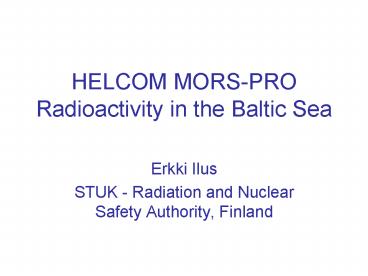HELCOM MORS-PRO Radioactivity in the Baltic Sea - PowerPoint PPT Presentation
1 / 18
Title:
HELCOM MORS-PRO Radioactivity in the Baltic Sea
Description:
and the Chernobyl fallout. in the drainage areas of. the rivers Kokem enjoki (A) ... on the Finnish coast after the Chernobyl accident. Radiation doses ... – PowerPoint PPT presentation
Number of Views:28
Avg rating:3.0/5.0
Title: HELCOM MORS-PRO Radioactivity in the Baltic Sea
1
HELCOM MORS-PRORadioactivity in the Baltic Sea
- Erkki Ilus
- STUK - Radiation and Nuclear Safety Authority,
Finland
2
Sources of artificial radioactivity in the Baltic
Sea
Total injections of Cs-137 and Sr-90 into the
Baltic Sea from different sources
Source Cs-137 TBq Percent of total amount Sr-90 TBq Percent of total amount
Chernobyl accident, incl. river discharges 4700 300 82 80 13
Nuclear weapons tests 800 14 500 81
Discharges from nuclear reprocessing plants in Western Europe 250 4 40 6
Discharges into the Baltic Sea from local NPPs, cumulative amount up to 2006 1.5 0.03 0.73 0.1
3
Special features of the Baltic Seaincreasing its
radioecological interest
- Location close to one of the test areas (Novaya
Zemlya) of the nuclear weapons tests carried out
in the 1950s - 1960s - Small volume of water
- Slow exchange of water
- Climatic conditions
- Large proportion of river waters
- Low salinity of water
- Scarce biota
- Sensitivity of the biota to changes in
environmental circumstances
4
History of Radioecological studies / Monitoring
of radioactive substances in the Baltic Sea
- 1959-1981
- National studies in different countries (in
Finland since 1959) - - bilateral and multilateral international
cooperation - 1981-1984
- Research programme on radioactive materials in
the Baltic Sea coordinated by the IAEA
(International Atomic Energy Agency) - 1986-1995
- HELCOM MORS Expert Group (Monitoring of
Radioactive Substances) - - first meeting in Helsinki 8-11 April 1986
- - participated by 7 countries
- 1996-
- HELCOM MORS-PRO
- - 3-5 years projects
- - participated by 9 countries
5
HELCOM MORS-PRO
- All the Baltic Sea countries have ratified the
Helsinki Convention - Helsinki Commission (HELCOM) coordinates the
international co-operation focusing on the
implementation of the Convention - Recommendation 26/3 of HELCOM defines the
programme for - Monitoring of Radioactive Substances (MORS) in
the Baltic Sea - All the Baltic Sea countries contribute to the
monitoring with their own national programmes - The results are reported annually to the HELCOM
data base - The results are published every five years in
Periodical Assessment Reports of HELCOM - Discharge data from all nuclear facilities
operating in the Baltic Sea area are reported
annually to the Discharge Register of MORS - STUK is responsible for the Finnish part of the
programme (120 annual samples from sea water,
bottom sediments and biota) - STUK is responsible for maintaining the Discharge
Register
6
Radiologically, the sea most affected by the
Chernobyl accident was the Baltic, since the
first radioactive clouds from Chernobyl travelled
to north and caused high deposition in the area
(Povinec et al., IAEA Bulletin 1/1996)
7
The average caesium-137 activity of the surface
seawater (Bq m-2) esti-mated for the reference
year 1990 (Povinec et al., IAEA Bulletin
1/1996). (The average values for the sub-regions
in the Baltic Sea (in brackets) are based on
Finnish data from 1990).
8
Terrestrial deposition of 137Cs in the Baltic Sea
drainage area (kBq m-2) compiled by STUK.
9
Gamma-emitting radionuclides in Fucus vesiculosus
(Bq/kg-1 dry weight) at sampling station
Olkiluoto A in 1985-1987
10
Estimated average con- centrations of 137Cs and
90Sr (Bq m-3) in the Both- nian Bay, Bothnian
Sea and Gulf of Finland in 1960-1982.
(IAEA-TECDOC-362)
11
Activity concentrations of 137Cs in surface
seawater at four stations in the Baltic Sea in
1974-2005. The activity concentrations of 40K in
seawater 1000 - 3000 Bq m-3.
12
Activity concentrations of 137Cs (Bq kg-1 dry
weight) in Fucus vesiculosus along the Finnish
coast in 1987 and the Chernobyl fallout in the
drainage areas of the rivers Kokemäenjoki (A),
Kymijoki (B) and Vuoksi (C).
13
Activity concentrations of 137Cs (Bq kg-1 dry
weight) in Fucus vesiculosus along the coasts
of the Nordic countries in 1991. The activity
concentrations of 40K in Fucus 500 - 1000 Bq
kg-1 d.w.
14
Vertical distribution (Bq kg-1 d.w.) of 137Cs in
sediment profiles at a coastal station of the
Gulf of Finland in 1986-2002.
15
Total amounts of 137Cs (Bq m-2) in bottom
sediments of the Baltic Sea in 1998.
16
Activity concentrations of 137Cs in Baltic
herring and pike in four areas along the Finnish
coast during 1975-2005.
17
Activity concentrations of 137Cs (Bq kg-1 fresh
weight) in seal flesh on the Finnish coast after
the Chernobyl accident.
Ringed seal (Phoca hispida) Grey seal (Halichoerus grypus)
Gulf of Finland May 1986 - November 1988 SW coast of Finland 1987 - 1988
98 5 (71 - 120) 176 63 (117 - 280)
18
Radiation doses
- The exposure of the population to radiation
caused by ingesting Baltic Sea fish and other
marine products and living by the sea after the
Chernobyl accident was evaluated in the EC/
Marina Balt Project in 1996-1998 - The dose for the Critical Groups living on the
coasts of the Bothnian Sea and the Gulf of
Finland peaked at 0.2 mSv in 1986 - This can be considered a very low value, as on an
average, - a Finn receives an annual 3.7 mSv dose from
other sources (2 mSv year-1 from indoor radon) - Since 1986, the impact of the Chernobyl fallout
has significantly decreased in the Baltic Sea - At the same time, individuals in the critical
groups had a dose rate of 0.7 mSv year-1 from
polonium-210 occurring naturally in the sea. - The average internal radiation dose from Baltic
Sea fish to Finnish - people was 0.01 mSv in 1986 and 0.002 mSv in
2006.































